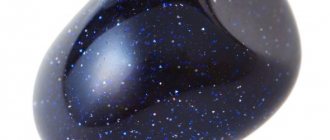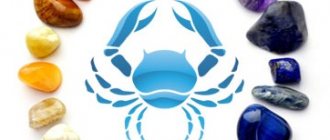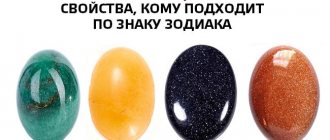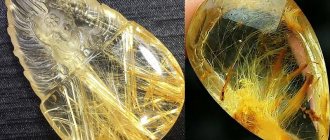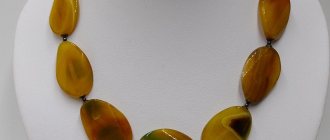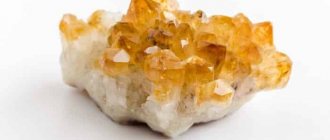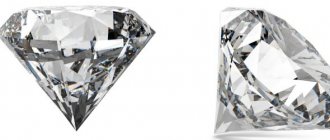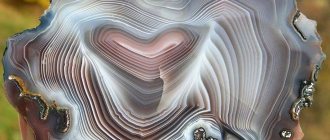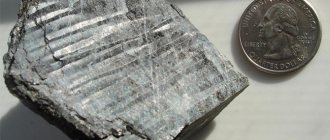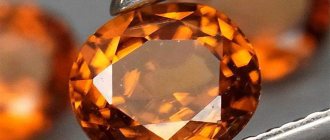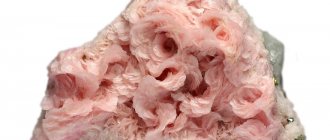Aventurine is one of the most beautiful, revered and mysterious gems in the world. An ancient legend says that the stone appeared due to the accidental fall of sparkles into a liquid glass mass in one of the workshops in Venice. The mineral aventurine is actually a fine-grained variety of quartz. The bright gem has long been popular. In China, it was called the “stone of emperors”, because it was from it that the seal of the ruler was carved. The Indians wore the gem as a talisman that protected them from all troubles. It was from India that the aventurine stone came to Europe. Europeans loved the gem so much that they made many things from it, from jewelry to figurines, vases and cutlery handles.
Physical and chemical properties
Aventurine is a silicon oxide. This quartzite has a complex fine-grained structure. It does not have a smooth (grainy) surface to the touch. The size of the depressions varies from species to species and depends on the conditions in which the stone was formed. Its color can be very different (green, black, brown, blue). It depends on the amount and type of impurities (mica, goethite, iron hydroxides, hematite). The stone is very durable (harder than glass). Its density is 2.5 g/cm3. Good for polishing. After processing, the gem acquires a characteristic glassy, oily sheen.
| Formula | SiO2 |
| Color | Green, red brown, gray yellow, pink, golden cherry, cherry white, brown, black, blue |
| Shine | fatty |
| Transparency | Absent |
| Hardness | 7 (out of 10) on the Mohs scale |
| Cleavage | Absent |
| Kink | Conchoidal |
| Density | 2.6 g/cm3 |
Areas of application
Transparent, beautifully colored crystals are in demand among jewelers.
Simple (not noble) beryl is used to obtain beryllium.
It is in great demand:
- For metallurgists (for alloying steels).
- In X-ray engineering.
- Nuclear scientists use beryllium to make neutron reflectors (protection against neutron radiation).
- For the production of heat shields and guidance systems (in the aerospace industry).
Expert opinion
Semenishcheva Polina
Specialist in mineralogy. Graduated from St. Petersburg Mining University.
FYI : In the Large Hadron Collider, a vacuum tube is made of beryllium at the point where the beams collide (whatever that means).
Aventurine colors
Aventurine is a very multifaceted gem. It acquired this feature due to the inclusion of various inclusions in its composition. The main color is always accompanied by various tints and inclusions of other colors.
- Blue aventurine is a very rare stone. Bright inclusions are clearly visible against a dark background. The most commonly counterfeited type of this mineral.
- Green aventurine (fuchsite) is a mineral from light green to dark green in color. Its composition necessarily includes chromium and mica flakes. It has a uniform color and characteristic shiny inclusions. They are clearly visible in sunlight. The most durable type of aventurine.
- Red aventurine is a mineral with a fine-grained structure. The characteristic color occurs due to the inclusion of hematite in its composition. Most popular for making jewelry.
- Honey-yellow aventurine has a characteristic pearlescent luster. It contains muscovite. The stones generally have a uniform surface. Porosity defects are quite rare.
- Pink aventurine has a weaker sparkle. Fine-grained type of rock.
- Black rock is the densest and heaviest. Characterized by uniform distribution of inclusions (hematite). Black aventurine is considered the most beautiful, but very rare type of stone.
Kinds
Aventurines vary in color and structure, which is due to the content of various inclusions and the uniformity of their distribution. For example, green aventurines are homogeneous, uniform and durable, while those painted in shades of gold and red are distinguished by the most pronounced sparkle.
Mineral deposits
Aventurine can be found in different parts of the globe. The mineral originates in clayey soil with sand under the influence of high temperatures and pressure from the earth’s crust.
In Russia, it is mined in the Southern Urals in the town of Taganay, Chelyabinsk region (since 1810). Here this stone received another name: “taganite”.
The gem is also mined in European countries such as Norway, Spain, and Austria. The Asian countries where mineral deposits are located are India and China. On the continents of North and South America, aventurine can be found in the USA, Brazil, and Chile. There are also mines of this gem in Australia.
Aventurine: magical properties of the stone
Aventurine protects its owner from external negative energy (damage, evil eye, gossip, envy, hatred). Protects the owner from premature or violent death. Its smooth surface reflects the flow of negative energy from a person.
The stone helps the owner cope with depression, makes him more cheerful and optimistic. Aventurine will bring you good luck in all positive endeavors.
There is an opinion that aventurine can make a person more carefree, even frivolous. Its owner or owner will easily and joyfully perceive all the events that occur. If a person is hyper-responsible, very worried about every little thing, then wearing this stone will make his perception of life easier. It can push him to more cheerful notes, give him confidence, and strengthen his leadership qualities. However, if the owner of the gem turns out to be a frivolous and very emotional person, then the stone can have a negative effect.
Many people use the mineral to protect a small child from damage and the evil eye. It is recommended to place it near the crib or stroller with the baby.
Aventurine is a symbol of great luck in all kinds of matters. Some of its varieties (gold, pink) are used to make talismans for gamblers. They are confident that wearing a stone significantly sharpens intuition.
- Blue aventurine is a talisman against accidental dangers of physical injury (from car accidents, falls, and other accidents).
- Green aventurine is an assistant in love affairs. He is able to improve relationships between lovers, bring harmony and mutual understanding. Aventurine increases the level of empathy of people wearing it, making them more susceptible to the needs of their other half.
- Black aventurine - used in magic by sorcerers. It helps you enter a trance state. Talismans in which this stone is instructed help develop psychic abilities. Seers and clairvoyants use it in their work.
- The brown gem has long been highly valued in the East. They believed that thanks to him it was possible to open an energy portal to the world of unearthly beings - devas and asuras.
Who is suitable according to their zodiac sign?
According to the horoscope, the stone is well suited to representatives of the earth element: Taurus , Capricorn and Virgo . The talisman will give them healthy adventurism. The wearer will no longer fear risk and will act as necessary.
However, you need to use jewelry in doses, otherwise it can cause excessive craving for extreme sports (addiction to gambling, riding a motorcycle) and other dangerous habits.
Taurus people should prefer blue gems. They will make the owner feel romantic. The mineral will improve existing relationships or help start new ones.
Virgos under the influence of aventurine become soft and sensitive. The mineral helps stabilize mood.
Representatives of the fire element should not wear a stone: Leo , Sagittarius and Aries . They are quick-tempered, can be harsh in their actions and are initially prone to risk. The stone will only sharpen these features. Excessive emotionality is fraught with deterioration in all areas of life.
In personal relationships, the carrier will become more conflicted, will openly criticize the partner and break down due to a bad mood. The owner will not be able to concentrate on work. Rigidity, cynicism and hysteria will arise.
For representatives of the water element, the mineral will become a source of vital energy. Pisces and Scorpios often generate good ideas, but they lack the strength to implement them. The stone will help avoid such a situation. With its help, Pisces will be able to avoid laziness, and Scorpios will be able to avoid decadent moods.
Cancers are most compatible with the gem. The stone will make them more open and bold and help them act. It will have a beneficial effect on health and improve rest.
For representatives of the air element, aventurine can become a love talisman. Gemini , Libra and Aquarius will attract the attention of the opposite sex. Intuition will sharpen, the owner will become more sensitive, so it will be easier for him to build trusting relationships. However, it is not recommended to wear the gem all the time; it is advisable to wear jewelry only on dates.
Medicinal properties
Aventurine has long been used in stone treatment (lithotherapy). Different minerals are credited with different healing properties.
Diseases for which this gem is used:
- baldness;
- various dermatitis, including psoriasis and eczema;
- cold;
- thyroid diseases;
- Strong headache;
- diabetes;
- kidney disease;
- obesity;
- changes in blood pressure.
Bioenergetics specialists use aventurine to relieve sick people of obsessive fears and phobias. The gem is able to establish proper sleep patterns.
However, everyone agrees that this mineral must be used extremely carefully when influencing the human psyche. The stone can enhance other negative character traits of the patient.
The place where the mineral is worn is also important. To treat diseases of the respiratory system, you need to wear all kinds of necklaces or beads. Rings or bracelets will help normalize the chemical composition of the blood and blood pressure. Improves the functioning of the cardiovascular system as a whole. Body massage using aventurine balls helps cure nervous disorders and improves metabolism. Applying the stone promotes skin regeneration and gets rid of dermatitis.
Main conclusions
Aventurine was popular in ancient times. It consists of quartz and small flakes of mica, thanks to which it emits a shimmer. There are different types of stone, which differ in color, deposit, and composition. Aventurine spar is ideal for Virgos, Taurus, and Cancers. It has medicinal properties, helps with cardiovascular, endocrine disorders, respiratory diseases, etc.
Requires special care, it is sensitive to temperature fluctuations and shocks. To distinguish natural sunstone from imitation, pay attention to its shine and the placement of mica flakes. Aventurine is inexpensive, so almost anyone can purchase a beautiful decoration and a powerful talisman.
Talismans and amulets
Aventurine is a very powerful talisman. It can bring unheard of luck, wealth, and love into a person’s life.
The stone is a talisman for creative people and travelers. It helps to acquire determination, discover talents, and achieve success.
The most common talismans are the same jewelry, namely beads, pendants, bracelets and others.
To obtain the magical properties of aventurine, a person can wear the stone on his body, or he can keep something inlaid with this stone in his house.
The stone should not be worn daily. To get the expected effect, you need to give the gem a rest.
Talismans containing green aventurine help the owner get a prestigious, well-paid job.
Amulets made from yellow stone are suitable for people who are mentally tired and often find themselves in stressful situations. The yellow gem perfectly restores a person’s moral and physical strength.
Black aventurine talismans give you self-confidence and increase your attractiveness to people around you. There is an opinion that amulets made of black aventurine are used in black magic.
Cherry aventurine talismans are made for children. The stone is able to avert dangerous situations from them.
Where is it used?
Aventurine in blue shades is used only for beauty or healing paraphernalia. It is more expensive than analogs of other colors, but buying a stone is problematic.
Blue aventurine jewelry is framed with white material. Natural stones are awarded platinum or gold; imitation stones are silver, cupronickel, jewelry or rhodium-plated alloy, and medical steel.
Blue gems in brooches, earrings, and pendants are complemented by stones of other shades. Most often these are sardonyx, coral, labradorite, rhinestones, cultured pearls, lapis lazuli, and crystal.
Brooch with blue aventurine stone
In almost all showrooms you can buy an imitation (it’s good if it’s made of Murano glass, not ordinary glass). The product description does not always indicate the origin, but the price serves as a marker.
Cost of jewelry with aventurine in the Russian segment:
- pendant 24 x 30 mm - 539 rubles;
- brooch - 889;
- suspension - 758;
- beads - 950.
Silver ring - 1900 rubles, earrings - 2100.
Products with imitation stone:
- ring - 250 rubles;
- earrings - 170;
- beads - 320;
- bracelet - 260.
A ball 50 x 50 mm is offered for 860 rubles.
Polished dark blue aventurine ball
Products with aventurine
The range of products with aventurine inserts is very diverse. First of all, the gem is used in the manufacture of jewelry (earrings, rings, bracelets, beads, pendants).
Various amulets made from this stone are widespread. They are made in the form of figurines of wild animals or symbolic geometric figures (pyramid, egg).
The mineral is used for inlaying boxes, vases, candlesticks, and interior items.
Story
The Italian word "aventura", which is the parent word for the name of the stone, translates as "happiness" and "adventure".
According to legend, this name was given to the stone in the 16th century in honor of its resemblance to the artificial material that Italian craftsmen obtained when copper filings got into the glass melt. The sparkling material looked very similar to natural stone. The mineral has been known since ancient civilizations. In ancient India, the stone served as a talisman for fakir and snake charmer. In the Middle Ages, Indian merchants brought aventurines to Europe, where their beauty was appreciated.
Aventurines have been known in Russia since the 18th century, and became especially popular after the discovery of deposits in the Urals. The mineral was used to make jewelry, vases, candlesticks, and cutlery. A vase with a height of 150 cm and a diameter of about 250 cm has been preserved in the Hermitage.
How to distinguish an original from a fake
You can often find fake aventurine on the market. As a rule, it is painted glass with sparkles.
If you decide to become the owner of this gem, then you need to know how you can easily distinguish the original from the fake:
- Stones that are most often counterfeited are black or brown. The glitter on them is distributed too evenly, in very large quantities. The size of the sparkles is larger than in the original copy.
- A fake stone will always be incredibly bright and have a more saturated color palette.
- Real stone scratches glass easily.
- The fakes are flawlessly smooth. A real mineral always has unique grooves and depressions.
- The most reliable result can only be obtained by carrying out physical and chemical analysis in specialized laboratories.
Artificial analogues
The rarity of the natural blue variety of the mineral has encouraged people to create imitations.
A worthy option is the synthetic stone “Cairo Nights,” which is visually indistinguishable from natural stone. Some people value it more than natural.
The basis is Murano (Venetian) glass - an alloy of quartz sand, soda and dyes. Real Murano has been made in Italy for nine centuries using traditional technology. The result is high quality and beautiful.
However, there is not much of it on sale.
Most products made from aventurine are imitations of Murano, created using primitive “aventurine” technology.
How to care for stone
It is preferable to store gemstone products in closed boxes or bags. This will help prevent other, harder jewelry from damaging the stone.
Cleaning the mineral is very simple. To do this, use warm soapy water and a piece of cloth. After finishing washing, the stone must be wiped dry with a soft cloth.
Under no circumstances should you use tooth powder or other strong chemical mixtures for cleaning.
Aventurine does not like significant temperature fluctuations. It is recommended to store the stone in a place that is not very warm.
As for not physical, but energetic cleaning of the gem, it is recommended to do it using running water (under a stream from a tap or in a river). Bioenergetics advises charging it with stronger positive energy under the bright rays of sunlight. However, you should not be too zealous; prolonged exposure to the sun can negatively affect the structure of the mineral.
Also, the stone does not like to remain forgotten for a long time, so it is necessary to wear it systematically.
Questions/Answers
We know a lot about beryl. It is impossible to write everything in an introductory article. If you have any questions, please ask!
How to distinguish a fake?
The color of dull-colored beryls is improved by heat treatment. Thus, a yellow-green or pale green crystal becomes blue after annealing.
The color of pale pink morganite (sparrowite) becomes richer after annealing.
Beryls are not obtained synthetically.
Please note : transparent beryl has a very high refractive index. Therefore, unscrupulous sellers can pass off a stone as a diamond. But only an expert can distinguish them.
Imitations of emerald through doublets are often made from colorless beryl. The faceted beryl is cut in half and glued with a green spacer.
Interesting : the Japanese synthesized beryls with zonal coloration of crystals. They are pink in the middle and green at the edges. Trade name "watermelon beryl" or "adashi beryl".
How to care?
- The crystals are quite hard, so you don’t have to treat them like fragile porcelain.
- But colored stones tend to fade in the sun. Therefore, prolonged exposure to the scorching sun is contraindicated for the stone.
- Place your jewelry in a case with thick, soft walls.
- Wipe the contaminated stone with a damp cloth.
Who should wear it?
- For travelers, as a talisman while traveling.
- Elderly spouses will benefit from paired beryl jewelry.
- Scientists and researchers.
- Businessmen.
- Participants in legal proceedings.
How to wear?
It is better for Taurus and Sagittarius to wear beryls set in silver.
What is the price?
The price of beryl is the sum of the properties inherent in a particular stone. This is color, transparency, purity.
I went through several online stores.
I report on prices:
- Beads (faceted) 18400-23750 rubles.
- Bracelets from 1000-3000 rubles.
- Rings from 10,500 to 85,000 rubles.
Beads for needlework from 1000 to 3800 rubles per thread.
For those who like to buy cut crystals and order exclusive jewelry.
We present to your attention:
- a pair of bright yellow heliodors (Brazil), price 4,000 rubles;
- goshenite, colorless (Madagascar), price 13,000 rubles;
- a pair of pink-peach morganites (Brazil), price 175,500 rubles;
- pale green crystal, antique cut, price 29,100 rubles.
What colors are there?
There are many of them:
- pink in different shades;
- red;
- violet;
- green;
- blue with a greenish tint;
- yellow, golden;
- brown;
- black.
The latter (very rare) is found in Mozambique, Brazil, and Madagascar.
There are colorless, transparent beryls.
Note : Namibian heliodor is often golden yellow in color. Therefore, in trade it is sometimes called “golden beryl”.
Where can I buy?
There are online stores from jewelry factories. There are just online stores. There are jewelry stores. Choose, study, buy.
When is the best time to buy?
- On lunar days. Buy at the beginning of the cycle (days 5 and 7), in the middle of the cycle (days 15 and 16), on the waning moon (days 21 and 28).
- The best day to buy is Wednesday.
- Buy emerald in May; aquamarine in late winter-early spring. Other beryls are best purchased in the fall.
What stones does it go with?
And again you will have to look at the information for each variety.
Water signs are ideally combined, as are all stones of the same element.
Stones of opposite elements do not suit each other. Many beryls belong to the element of Air. But not heliodor, not emerald, not aquamarine.
